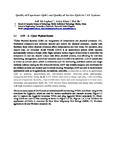Quality of Experience (QoE) and Quality of Service (QoS) in UAV Systems
| dc.contributor.author | Laghari, A | |
| dc.contributor.author | Khan, Asiya | |
| dc.contributor.author | Hui, H | |
| dc.contributor.editor | Estrela E | |
| dc.contributor.editor | Hemanth J | |
| dc.date.accessioned | 2019-01-21T15:07:17Z | |
| dc.date.available | 2019-01-21T15:07:17Z | |
| dc.date.issued | 2019-02-28 | |
| dc.identifier.isbn | 9781785616440 | |
| dc.identifier.uri | http://hdl.handle.net/10026.1/13197 | |
| dc.description.abstract |
This chapter studies both the quality of service (QoS) and quality of experience (QoE) of unmanned aerial vehicle cyber-physical systems (UAV-CPSs). These parameters help to gather data about the connectivity options in networks containing flying nodes (FNs), ground stations (GSs) and other associated devices. They also support to solve complications related to the number of choices of subnetworks complicates designs, capacity, spectrum efficiency, network coverage and reliability among other issues from a flying ad hoc network (FANET) especially when there is streaming. QoS and QoE permit the discovery of the best conceivable network configurations, and costs for user applications autonomously. Existing lines of attack are listed by function. Restrictions and strong points are emphasised to arrange for initial investigations as well as further studies in this area. If the UAV-CPS network has low QoS, then real-time data will not be accurate and subject to data losses causing inaccuracies. Information loss or delay (due to packet loss, rearrangement and delay) may lessen the satisfaction level of the UAV-CPS user (operator). Network QoS degradation affects the real-time video monitoring and must always be taken into account with on-board needs. This effect leads to data loss and image quality reduction, thus decreasing the QoE. | |
| dc.format.extent | 215-245 | |
| dc.language.iso | en | |
| dc.publisher | Institution of Engineering and Technology | |
| dc.relation.ispartof | Imaging and Sensing for Unmanned Aircraft Systems: Volume 2: Deployment and Applications | |
| dc.title | Quality of Experience (QoE) and Quality of Service (QoS) in UAV Systems | |
| dc.type | chapter | |
| plymouth.publication-status | Published | |
| dc.identifier.doi | 10.1049/pbce120g_ch10 | |
| plymouth.organisational-group | /Plymouth | |
| plymouth.organisational-group | /Plymouth/Faculty of Science and Engineering | |
| plymouth.organisational-group | /Plymouth/Faculty of Science and Engineering/School of Engineering, Computing and Mathematics | |
| plymouth.organisational-group | /Plymouth/REF 2021 Researchers by UoA | |
| plymouth.organisational-group | /Plymouth/REF 2021 Researchers by UoA/UoA12 Engineering | |
| plymouth.organisational-group | /Plymouth/Users by role | |
| plymouth.organisational-group | /Plymouth/Users by role/Academics | |
| dc.rights.embargoperiod | Not known | |
| rioxxterms.versionofrecord | 10.1049/pbce120g_ch10 | |
| rioxxterms.licenseref.uri | http://www.rioxx.net/licenses/all-rights-reserved | |
| rioxxterms.type | Book chapter |


